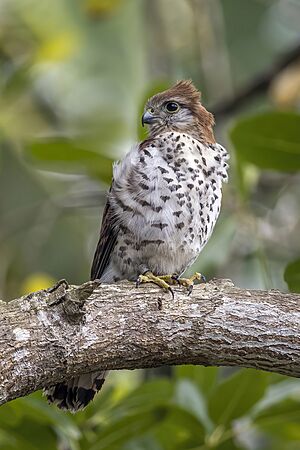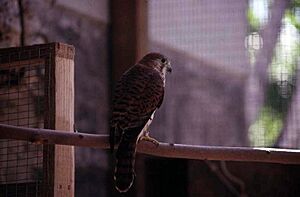Mauritius kestrel facts for kids
Quick facts for kids Mauritius kestrel |
|
|---|---|
 |
|
| Ebony Forest, Mauritius | |
| Conservation status | |
| Scientific classification | |
| Genus: |
Falco
|
| Species: |
punctatus
|
The Mauritius kestrel (Falco punctatus) is a special type of bird of prey. It belongs to the Falconidae family. This bird lives only in the forests of Mauritius. You can find it in the forests, cliffs, and deep valleys of the island's southwestern area.
This kestrel is very unique compared to other kestrels in the Indian Ocean. It likely came to Mauritius a very long time ago, during the Late Pliocene period. Over time, it changed and became its own distinct species.
In 1974, the Mauritius kestrel was almost gone. There were only about five or six birds left. Two were in captivity, and only one female was breeding in the wild. By 1985, their numbers had grown a little. But it was still in great danger, with fewer than 15 birds in the wild.
Thanks to amazing conservation work by Carl G. Jones and Abdool Wahab Owadally, the number of kestrels grew. By 2019, there were around 400 birds. This success story is one of the best examples of saving a bird species. In March 2022, it became the national bird of Mauritius. This was to celebrate 30 years of Mauritius being a republic.
Contents
About the Mauritius Kestrel
The Mauritius kestrel is a small bird. It can grow to be about 26 to 30.5 centimeters (10 to 12 inches) long. It weighs up to 250 grams (about half a pound). Male kestrels are usually a bit smaller than females. Their wings spread about 45 centimeters (18 inches) wide. Unlike other falcons, their wings are rounded. These birds can live for about 15 years when they are cared for by humans.
What They Eat and How They Hunt
The Mauritius kestrel hunts by flying quickly through the forests. It is a carnivore, meaning it eats meat. Its diet includes geckos, dragonflies, cicadas, cockroaches, crickets, and small birds.
Saving the Mauritius Kestrel
A long time ago, before people settled widely on Mauritius, there were more kestrels. Scientists think there were about 175 to 325 breeding pairs. Their numbers likely dropped because of deforestation (trees being cut down) and strong storms called cyclones.
But the biggest drop in numbers happened in the 1950s and 1960s. This was due to a harmful pesticide called DDT. Also, new animals brought to the island, like cats, mongooses, and crab-eating macaques, killed kestrels and their eggs. A close relative, the Réunion kestrel, became extinct around the 1670s.
Early Efforts to Help
Mauritian naturalists Jean Vinson and France Staub noticed the kestrel was almost gone. An American falcon expert named Tom Cade heard about it. In the early 1970s, he talked with Leo Edgerly, who worked with forests. They thought about how to save the kestrels. Tom Cade knew how to breed falcons in captivity. He believed they could do the same for Mauritius kestrels. Then, they could release the birds back into the wild.
In 1973, a project to save the Mauritius kestrel began. It involved international groups like the World Wildlife Fund and the Mauritius Forestry Department. Stanley Temple, one of Tom Cade's students, started the work. He studied the birds in the wild and began a program to breed them in captivity.
Challenges and Breakthroughs
In 1974, the number of wild kestrels dropped to only 4 birds. It was called the rarest bird in the world. Stanley Temple tried to breed them in captivity in 1973, but it failed. The baby bird died when its incubator broke down.
Later, in 1979, a new effort started. With help from Gerald Durrell, a biologist named Carl Jones set up a wildlife sanctuary. He bravely climbed trees to take eggs from nests. This time, the eggs were fertile, and Jones successfully hatched the chicks in incubators.
Helping Birds Lay More Eggs
Scientists had learned that if you take the first set of eggs from a kestrel, the bird often lays a second set. This is called 'double clutching'. The young birds from the second set are just as healthy as those from the first.
In 1981 and 1982, Carl G. Jones and his team used this method. They removed the first eggs from wild kestrel nests. They also gave the wild kestrels extra food. This helped the birds lay new eggs without harming them.
A Growing Population
Slowly, the kestrel population began to grow. By 1984, there were an estimated 50 birds. The methods for breeding and releasing young birds improved a lot. The captive breeding center became a leading place for studying and saving falcons.
The captive breeding program was reduced in the early 1990s. This was because the wild population could now survive on its own. Since 1994, the program only acts as a backup. It helps if something bad happens to the wild birds. The center also helps other rare birds from Mauritius, like the pink pigeon.
By 2005, there were at least 800 adult birds. The remaining forests on the island could support about 50 to 150 more. These birds live mostly in the Black River Gorges area. In 1994, the IUCN changed the kestrel's status to vulnerable. This meant it was less endangered. This happened because releasing captive-bred birds was no longer needed.
Just two decades after being almost extinct, the kestrel was doing much better. Today, people mainly monitor the birds. They also control the animals that were brought to the island and harm the kestrels.
Current Status and Future
In 2014, the kestrel's status was changed back to endangered. This was because its population started to decline again. It is believed that there are now fewer than 400 adult birds in the wild.
Even when there were very few kestrels, they managed to survive. This is because their ancestors on the volcanic island of Mauritius had survived many volcanic eruptions. These eruptions kept the kestrel population small for a long time. This helped them become very strong and able to survive with low numbers.
Being on a small island means the kestrels are still at risk. Strong storms, which might happen more often, could harm a large part of the population. This is why the Mauritius kestrel is still classified as an endangered species.
Images for kids








